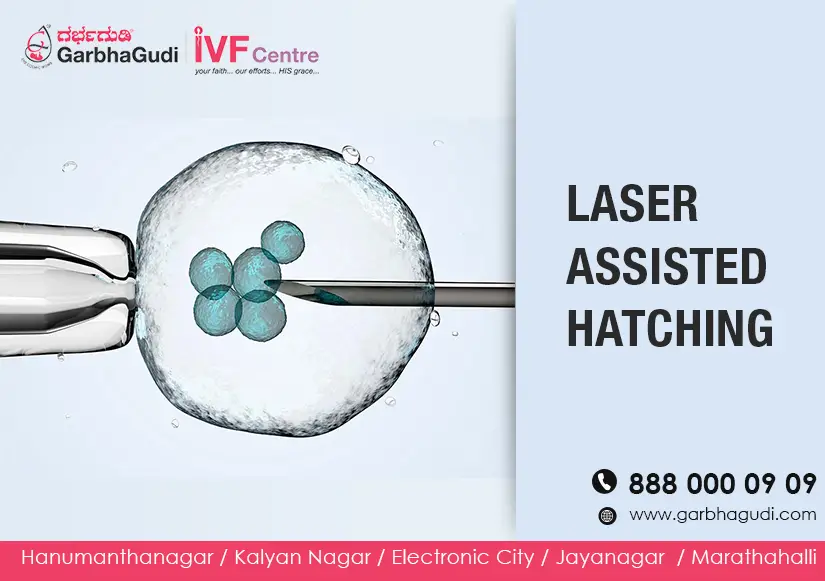Laser Assisted Hatching Yet another advanced scientific solution for a couples aspiring to have their own baby. There are plenty of questions for anyone undergoing infertility treatment, especially when there is no success after repeated consultations and treatment. There are various problems associated with conceiving… A failed IVF and a negative pregnancy test isn't the end. Remember, it is the first step towards completing your family. Identifying the root cause for unsuccessful IVF and correcting it is the key to success in the next cycle. There are numerous causes for negative IVF result. It could be due to abnormalities in the egg, abnormalities of the sperm or an improper selection of the embryo to transfer into the uterus or an issue in the uterus (endometrium), imbalance in the hormones etc. One such cause is a thickened or non-uniform zona pellucida layer around the egg. What is Zona Pellucida?Soon after fertilization of the egg by the male sperm, the formed embryo starts growing and eventually forms cells that make up a protective shell around the embryo and this is called zona pellucida. The embryo passes into the uterus after fertilization and naturally breaks out of its shell, expands and then implants into the wall of the uterus where the foetal development occurs. Sometimes, the zona pellucida layer fails to break preventing the embryo from implantation and hence there could be a missed chance to conceive. What is Assisted Hatching? Assisted hatching is one of the assisted reproductive procedures for women who have repeated failed IVF cycles or various other unidentified problems that could prevent pregnancy. The procedure which helps to break a thickened zona pellucida in-vitro to help with subsequent implantation is called Assisted Hatching. Who require Assisted Hatching procedures?● Women with previous failed IVF cycles. Not all the women undergoing IVF would require an assisted hatching procedure. Only those with other medical conditions which reduce the chances of conceiving and are undergoing an IVF procedure are recommended to for this procedure.● Women with age >35yr● Frozen embryo transfer where the chemicals used to preserve the embryo might thicken the outer shell of the embryo.● Increased Follicle-stimulating Hormone levels on 2nd day of the menstrual cycle.● Zona pellucida with a thickness of >15umVarious Methods of Assisted Hatching There are various methods for Assisted Hatching:● Mechanical methods: Method 1: This is done as a part of the IVF procedure before the embryo is transferred into the uterus. Here, the embryos are placed in an alignment steadily and the zona pellucida is partially dissected using a micro-needle. Method 2: Another method of mechanical hatching is by using hydrostatic pressure to help expand the zona pellucida layer to assist in hatching. Method 3: In this method, the embryo is subjected to vibrations created by drilling. This causes a cone-shaped opening of the zona layer.● Chemical methods: The Embryos are arranged in an alignment similar to that of mechanical methods and are treated with a chemical called Tyrode’s solution for 40sec. The Tyrode's solution is aimed at the pile of arranged embryos with a controlled speed. This helps to make the zona pellucida layer thinner and easier to hatch naturally.● LASER ASSISTED HATCHING: In this technique, a diode laser is used to break open a part of the zona layer. A diode laser of 1480nm wavelength is focused onto the embryo in a non-contact mode at various power settings. There are low, medium and high power settings (35mV,45mV and 55mV respectively) are used depending on the thickness of the zona pellucida layer. Laser-Assisted Hatching comes with a software that is designed for easy positioning, focus and measurement of embryos and simple alignment of the laser. The laser has three preset energy intensities that can be delivered in a single 25 ms pulse with a single click of the mouse. Low power is used for perforating very thin zona or to minimize exposure, medium power for drilling the zona of most embryos and high power for perforating thick or hard zona pellucida layer. Procedure:● Those women selected for the assisted hatching procedures are prior evaluated thoroughly about their medical history and a set of tests before initiating the process.● The assisted hatching procedures are carried out on 3rd day after the fertilisation. Around 5th day, embryos are ready to implant into the uterus wall.● The technique involves focussing the laser light precisely on to the embryo to create a gap on the zona pellucida layer helping it to hatch.● The so treated embryo is transferred back to the uterus for subsequent foetal development. How Successful? Laser hatching procedure is considered to be the safest of all these hatching methods and is recommended for women with previous failed IVF procedures. Most of the clinicians believe this to be a better option for couples eagerly awaiting a baby. Performed under the guidance of skilled embryologists and clinicians, the process of laser-assisted hatching is reported to have minimum complications and good success. There are happy couples already blessed by undergoing this procedure. Lasers have proved their effectiveness in various fields including modern medicine. They can be a light of bliss for couples waiting a complete family. At GarbhaGudi, miracles happen often, as the team is made of highly skilled embryologists and clinicians who constantly strive to give extraordinary results. For further details, you can also write to GarbhaGudi at dreams@garbhagudi.com or directly talk to our team at 8880000909Follow us on Facebook Twitter LinkedIn Instagram Pinterest
Disclaimer: This is a user generated content submitted by a member of the WriteUpCafe Community. The views and writings here reflect that of the author and not of WriteUpCafe. If you have any complaints regarding this post kindly report it to us.






